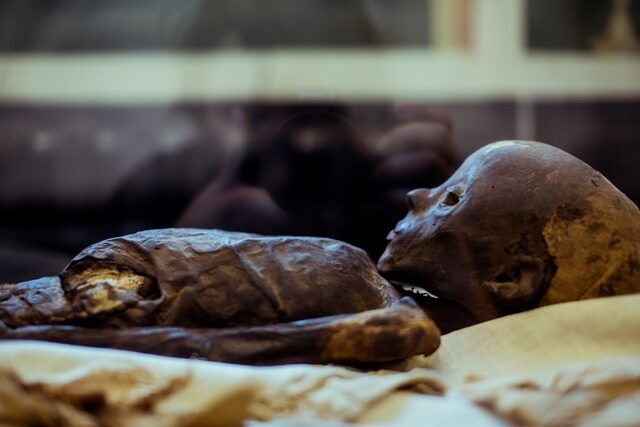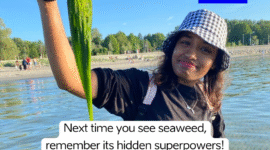In 1819, the district magistrate of Livonia, Otto Magnus von Richter, gifted to the University of Tartu a collection of relics assembled by his Orient-interested son during his travels to Egypt. His goal was to encourage scientific enterprise in the coming generations. Among other pieces, the ancient relics included two human mummies from Egypt and the mummies of a dog and a bird.
In the second half of 2017, twenty researchers from different fields started to examine these two human mummies. With questions lingering as to their origin and background, the only thing certain about these mummies was that they were boys. Everything else needed to be researched and analysed. Scientific enterprise sure got encouraged!
Ester Oras, senior researcher of archaeology and chemistry at the University of Tartu, said that for her the mummy project was one of the best examples of interdisciplinary collaboration. “We had researchers from a variety of fields within the humanities, of course from the museum itself and also many specialists from the natural sciences. We had specialists in textile analyses, 3D modelling, osteology, analytical chemistry, DNA studies, biology and entomology, medicine and dedicated mummy studies researchers all actively involved. Despite this variety, the common question regarding the authenticity and origin of the mummies bound us together so organically that we almost forgot that we represented different disciplines,” she noted while describing the collaboration.
Jaanika Anderson, head of the University of Tartu Art Museum, highlighted that, for the museum, such collaboration is the only sure way to reveal information about its collection due to the impossibility of having such a full spectrum of specialists in its employ. “Developing these types of collaborations is very important today and it is highly beneficial if we can cooperate with people who are actually near. Moreover, scientific value is also vital to a collection,” Anderson explained.
Working together minimizes destruction
Oras noted that they discussed the sampling strategies together, took the samples together, discussed the process of the analysis together and, of course, examined the results of the analysis as a cohesive whole. “This is in fact something that makes this project rather unique within the broader field of mummy studies. Usually, mummies are studied and the published results concentrate on highly specific aspects such as embalming resins, bone analysis, animal mummy studies – all separately,” she explained. “But we managed to combine all these different aspects. We’ll publish them together and I truly believe that this manner is extremely beneficial for producing better and more cohesive knowledge regarding these unique heritage artefacts.”
Vice director of the Institute of Genomics, Mait Metspalu, said that collaboration between geneticists and archaeologists is becoming more and more common and opens up new possibilities for comprehensive reconstruction of the past. He was impressed by the high level of different analyses, citing textile analysis as an example. “It was very interesting and just cool to listen to how and what the other researchers do,” he said.
As an added bonus, this kind of approach allowed researchers to minimize the destructive aspect of sampling because the same samples were used for as many analysis as possible. “This is extremely important when analysing rare heritage objects, which these old Egyptian mummies certainly are,” Oras said.
What is more, on the research team is also a premier mummy studies specialist: Dario Piombino-Mascali from Vilnius University. In this regard, it is truly possible to situate the results within the wider field of mummy studies. Oras has already confirmed that this collaboration is expected to yield other interesting results in the future.
Cause of the death is still up in the air
While some of the analyses have already been completed, others are continuing in a more detailed manner. For instance, researchers will utilise different instruments to characterise the embalming resins as specifically as possible; stable isotope analysis will be conducted to identify the diet of the boys; and bugs are being analysed by an entomologist. They also aim to establish the embalming process with regard to how, where, when and with what substances were the bodies treated and handled.
“The work is, to some extent, still ongoing but we do not expect any major surprises. Rather, the aim is to go into as much detail as possible and be absolutely certain about our results,” Oras said.
Indeed, one interesting aspect still under consideration is the reason the boys died in the first place, Oras mentioned. “It does not seem to be anything related to clear physical trauma or an accident, but rather a disease or something. So, this occupies our minds to some extent. We’ll see whether we will perhaps be able to answer this at some point,” she said.
Metspalu emphasised that if the newly generated information pertaining to these mummies finds a place in a big database, it would be interesting to then compare different mummies and other relics from that era in order to gather more knowledge regarding the social structure of society at that time.
The research team also plans to publish the results in an international research journal, since mummies are certainly of worldwide interest. They are working on the manuscript at the moment, with the hope that the paper(s) will be released later this year. Meanwhile, the main results are currently available to visitors of the mummy chamber at the University of Tartu Art Museum.
Written by Marii Kangur
This article was funded by the European Regional Development Fund through Estonian Research Council.
 Back
Back



